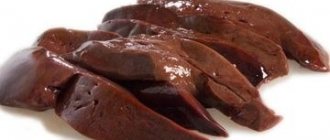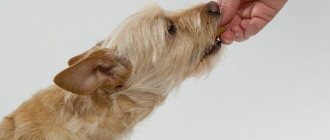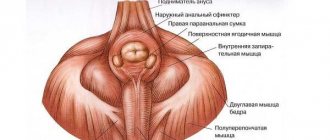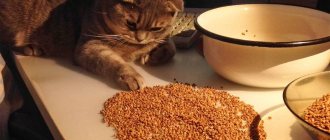I know that, like me, you need to make sure your raw-fed pet gets everything he needs from his diet. Vitamins, minerals, fatty acids.
Below I will detail the importance of raw liver in your dog's diet. If your dog doesn't like liver, fear not! I'll share feeding tips and tricks at the end of the post.
If you have researched how to feed a raw food dog, you know that 10% of the diet should be organs and half should be liver.
What's so important about feeding raw liver to dogs?
The liver (actually all secreting organs) is considered one of nature's most powerful superfoods.
Why is liver good for your dog? The liver of everything from beef to duck is very rich in many essential nutrients.
Throughout history, people around the world have highly valued organ meats such as liver for aiding fertility, growth and development, maintaining high energy levels, mental health and more. Some cultures consider liver so valuable that they do not touch it with their hands.
I'm going to share with you why liver is one of the most nutrient-dense foods on the planet, rich in vitamin A, iron, B vitamins (especially B12), phosphorus and magnesium.
© shutterstock
Delicacies made from dried
Liver treats are dense and crunchy pieces that are great for training and rewarding your four-legged friend.
Purchased options are very convenient, but you need to choose them responsibly. This high-quality delicacy consists of 100% natural beef liver. The product must not contain additional ingredients or impurities. The offal must be well dried, otherwise pathogenic bacteria may appear in this treat, and this is dangerous for the pet’s health.
Ideally, the manufacturer thinly slices the liver on a slicer and dries it for about 6-7 hours in a professional oven. Only after this the product appears on store shelves.
You can make a similar delicacy with your own hands. To do this you will need:
- 200-300 gr. liver;
- parchment paper;
- 1 tsp vegetable oil (optional).
Before preparing the delicacy, it is recommended to soak the liver in cold water (2-3 hours).
Reference. The water will become cloudy during soaking and should be replaced as needed. If the water remains clear, you can start cooking.
Cut the liver into small cubes. The size of the piece should allow you to eat it at a time. After this, place the workpiece on parchment paper; if desired, it can be lightly greased with vegetable oil. Place in an oven preheated to 180 degrees. Turn down the heat. Dry at minimum temperature for about 30-40 minutes.
Cooking time should be adjusted based on the size of the pieces. The treat should be moderately hard and decrease in size by about 1.5-2 times. This treat should be stored in the refrigerator. Use within 3-4 days.
It is not recommended to give dried liver to old dogs and pets that have serious dental problems (periodontitis, pulpitis, caries). The hard texture is difficult to chew and can harm the animal’s oral cavity. But healthy puppies, pregnant and lactating individuals can easily handle this delicacy.
Benefits of Feeding Raw Liver to Dogs
If you compare the overall nutrient density of liver to other “superfoods,” you will see that liver beats them all because of how rich it is in vitamins and minerals per gram.
Raw liver is rich in vitamin B12
The #1 benefit of feeding dogs raw liver is that it is very rich in vitamin B12. In fact, liver is the biggest source of vitamin B12 for your dogs. Vitamin B12 promotes the formation of red blood cells and improves cellular function. Your dogs also need vitamin B12 for nervous system function, metabolic support, and brain health.
Feeding dogs raw foods high in vitamin B12 helps prevent B12 deficiency, which can cause fatigue, muscle weakness, decreased mental function and mood changes.
Raw liver is an excellent source of vitamin A
The liver is one of the most concentrated natural sources of vitamin A. Vitamin A is a fat-soluble vitamin essential for good vision, overall eye health, skin health, thyroid health, strong bones, gene regulation, facilitating cell differentiation and immune function. It also helps reduce inflammation by fighting free radical damage.
What's even more important about vitamin A found in liver is that it is the active form (also called retinol). Active vitamin A can be used directly by the body and does not need to be converted first like plant-based vitamin A. Of course, your pet carnivore cannot fully utilize the plant matter, let alone convert the plant-based vitamin A that makes organ meats necessary for a complete raw food diet.
Raw liver high in iron
If your dog is struggling with any type of anemia, which is often associated with iron deficiency, then liver is one of the best foods to feed.
Liver contains a powerful combination of folic acid, iron and vitamin B12. These are the three vitamins and minerals your dog needs to overcome anemia naturally. This combination may also help treat symptoms such as low energy, fatigue, or neurological problems.
Raw liver is rich in vitamin B6, biotin and folate
In addition to vitamin B12, liver is rich in vitamin B6, biotin and folic acid.
These vitamins help perform cellular functions. When DNA production is disrupted, it causes megaloblastic anemia, one of the signs of folic acid deficiency.
Contains copper, zinc, chromium and selenium
The liver also provides smaller amounts of nutrients, including copper, zinc, chromium and selenium, which have far-reaching benefits for your dog's metabolism, central nervous system and endocrine system.
© shutterstock
Supports Liver Function
You're thinking, "Isn't liver toxic? Is your liver unable to deal with toxins? Then how to feed safely?
In fact, toxins are cleared by the liver, but are not stored in it. The liver helps filter waste and toxins from the blood so they can be flushed out of the body. The liver is also responsible for metabolizing medications, hormones, plus the liver helps produce proteins needed for blood clotting.
In fact, feeding dogs raw liver is an effective liver cleanse, especially when it is part of an overall healthy raw diet, as it provides your dogs body with all the nutrients their own liver needs to remove waste from their systems.
Raw Liver Provides CoQ10
Both the liver and heart are rich sources of CoQ10. CoQ10 has been linked to cardiovascular and vascular health, improved endurance, reduced inflammation, and more. The organs are where the greatest supply of CoQ10 can be found.
CoQ10 stores in your dog's body decrease as they age, so feeding dogs raw liver is essential to maintain levels.
How to choose?
So, when choosing a treat for your four-legged friend, pay attention to several important points. Firstly, the color of fresh liver is red-brown, even, without spots. The color of the blood underneath should be scarlet. If the blood is dark, then the liver is stale.
The second important point is the smell. If you smell a slight aroma of ammonia, then this is a sign of staleness; the smell should be sweetish.
The third point is appearance. Fresh liver should be elastic, smooth, slightly moist, without scratches or dents.
Important. Stale food can cause food poisoning in your dog. Be careful!
It is worth saying that in addition to a fresh piece, you can also buy frozen liver in the supermarket. As a rule, it is slightly lower in cost, but it also contains fewer nutrients, so it is better to choose fresh liver.
Which liver is the best?
The livers of different animals have slightly different properties, but for the most part, the livers of different animals provide similar nutritional benefits.
Below are the different types of liver you can find in grocery stores, farmers' markets, local butcher shops, or even online:
- Chicken Liver – Chicken liver has the mildest flavor, making it a good snack. Chicken liver has more fat, folic acid and iron than beef liver.
- Beef Liver – Compared to chicken liver, beef liver contains slightly more vitamin B12, vitamin B6, vitamin A, zinc and phosphorus.
- Fish Liver – Fish liver (even better, whole fish) is an excellent source of omega-3 fatty acids, vitamin A and vitamin D.
You can also feed lamb, mutton, goat, duck, turkey, goose liver, rabbit liver, etc.
Adding pork meat to industrial feeds
For pet owners who decide to give dry or wet commercial food, manufacturers have developed a balanced diet. In specialized stores you can purchase different types of food, including a line of food with pork.
Buyers are attracted by its high nutritional value, as well as the high content of macro- and microelements. A big advantage of use is its almost complete hypoallergenicity. The technology for the production of dry and wet industrial feed eliminates all the dangers associated with intestinal parasites and pathogenic bacteria. In addition, their fat content is precisely calculated, so food containing pork is completely safe.
General Facts About Eating Raw Liver
According to the USDA, 30 grams of chicken liver contains the following:
Note : These figures refer to the liver of industrially bred chickens. We'll talk more about this in a minute, but the quality of the liver you feed is very important. These numbers are higher in pasture-raised animals.
- 2 grams fat
- 6 mcg vitamin B12
- 4076 IU vitamin A
- 162 mcg folic acid
- 6 milligrams vitamin B2 (riboflavin)
- 23 milligrams selenium
- 9 milligrams vitamin B5
- 6 milligrams iron
- 9 milligrams vitamin B3/niacin
- 2 milligrams vitamin B6
- 125 milligrams phosphorus
Contraindications
The offal itself can be harmful only because it contains a lot of cholesterol.
Experts do not recommend introducing it into your pet’s diet in several cases:
- Old age of the dog.
- The presence of pathologies of the gastrointestinal tract.
- Kidney problems.
- Manifestation of food allergies.
- Pregnancy in females.
In all other cases, the liver, if properly processed, will not harm the health of the pet.
Feeding dogs who are picky eaters
If your dog is liver averse, the first thing you need to do is practice tough love. Don't give your dog a choice. Make it clear that they should eat the food you give them. Save and return what they didn't eat (don't add anything) at their next meal.
Liver is not the most delicious food, so it is best to freeze it before feeding it to your dog. Frozen raw liver doesn't taste as strong.
Add raw liver to your dog's diet slowly to avoid causing digestive upset.
Preparation
In order for your four-legged friend to happily devour boiled liver, it must be prepared correctly. First, the piece must be cleared of veins, then rinsed and placed in cold water for about 30-40 minutes. After this, put on moderate heat and cook for about 25-30 minutes.
You can add vegetables to this dish (carrots, white cabbage, zucchini, cauliflower). This way the liver will be saturated with a pleasant vegetable aroma and become even tastier.
The liver can not only be boiled, but also stewed. But it is not recommended to give it fried to a dog. Because during frying it becomes tougher, drier and less healthy (cholesterol levels increase).
Recipes
In addition to primitive dishes, you can create real culinary masterpieces, such as pate or liver pancakes. For the pate you will need:
- 200 grams of liver;
- 1 tbsp. spoon of cream;
- 1 teaspoon of vegetable oil.
Clean the liver and cut it into small pieces. Simmer it with vegetable oil over low heat for 10-15 minutes, then add a spoonful of cream, then grind the mass in a blender.
The pate can be given to your dog in the form of small balls or mixed with your favorite porridge.
For pancakes take:
- 100 gr. liver;
- 50 gr. butter;
- 1 teaspoon of vegetable oil;
- 1 chicken egg.
Rinse the liver and grind in a blender, then add butter and egg. Add vegetable oil to a hot frying pan and pour in the pancakes. Let the crust “set”, then cover with a lid. Simmer for about 10-15 minutes.
Diseases from pork due to improper feeding
Is it possible to give pork to a dog? Pork is poorly absorbed in the body due to its fat content. In large quantities, meat accumulates in the body and harms the liver, leading to excess weight in the pet.
The digestive tract simply does not accept heavy foods, so getting rid of obesity in this case is difficult. Therefore, it is worth thinking several times before using pork for feeding.
In addition, this meat can be a source of plague, pseudorabies, toxocariasis, taeniasis, and trichinosis. All diseases are quite dangerous, some often fatal.
It is a myth that pork can cause volvulus in dogs. With a dense diet, it is not recommended to load your pet immediately after eating; this is what leads to such a problem for the pet.
Large breeds of dogs such as shepherds, especially young ones, are at risk. For their diet, it is better to consult a doctor.
Therefore, veterinarians treat this meat with such prejudice, but if you follow all the recommendations, adding pork is possible.
Allergy to meat in a dog
There are frequent cases of allergies in dogs to a certain type of meat. Allergic symptoms are standard and include:
- itching, rash, redness, peeling, hair loss;
- discharge from the eyes, ears, nostrils;
- swelling of the muzzle, some parts of the body, mucous membranes;
- labored breathing;
- unpleasant odor;
- frequent stool.
Any food can cause similar symptoms. Each organism has its own characteristics; representatives of the same breed have different reactions to specific foods. When introducing an innovation to the diet, it is important to monitor the pet’s condition; food that provokes allergic symptoms is excluded from the menu.
In some cases, blocking allergic symptoms requires the use of medications - hormonal, antifungal, antihistamines, antibiotics and other drugs. Drug elimination of the consequences of allergies occurs under the supervision of a veterinarian.
Akriderm GK preparations for allergic dermatitis
The combined composition gives the drug "Akriderm GK" wide application possibilities.[4] It includes topical glucocorticosteroids, which show a high degree of effectiveness in combating the manifestations of atopic and allergic pathologies. These products are a powerful blow to the inflammatory focus, since Akriderm GK preparations contain three active ingredients:
- Betamethasone – has anti-inflammatory, antiallergic, antiexudative and antipruritic effects.
- Gentamicin – has a bactericidal effect.
- Clorimazole – has a pronounced antifungal effect.
Consequently, Akriderm GK ointment and cream have a comprehensive effect on the diseased areas of the skin, contributing to its restoration and improvement of the patient’s condition. The drugs relieve itching, redness and inflammation and help eliminate pathogenic microorganisms. These drugs can be used to treat both acute phase and chronic inflammation. Both ointment and cream are well absorbed into the skin and penetrate deeply into the lesion. For a more accurate choice of the appropriate drug, it is recommended to consult a specialist.











